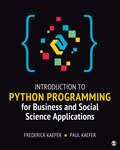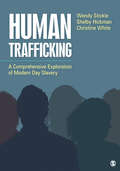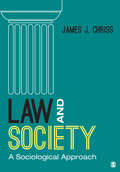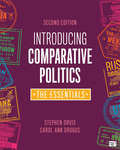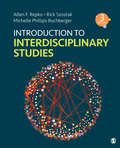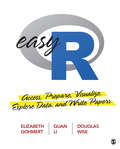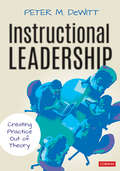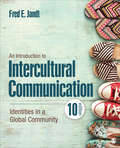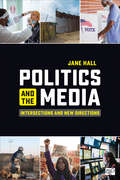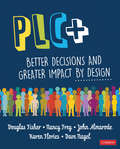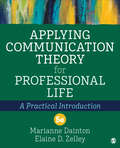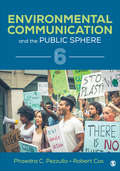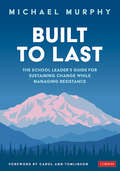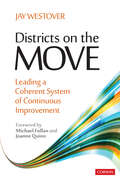- Table View
- List View
Introduction to Python Programming for Business and Social Science Applications
by Paul Kaefer Frederick KaeferWould you like to gather big datasets, analyze them, and visualize the results, all in one program? If this describes you, then Introduction to Python Programming for Business and Social Science Applications is the book for you. Authors Frederick Kaefer and Paul Kaefer walk you through each step of the Python package installation and analysis process, with frequent exercises throughout so you can immediately try out the functions you’ve learned. Written in straightforward language for those with no programming background, this book will teach you how to use Python for your research and data analysis. Instead of teaching you the principles and practices of programming as a whole, this application-oriented text focuses on only what you need to know to research and answer social science questions. The text features two types of examples, one set from the General Social Survey and one set from a large taxi trip dataset from a major metropolitan area, to help readers understand the possibilities of working with Python. Chapters on installing and working within a programming environment, basic skills, and necessary commands will get you up and running quickly, while chapters on programming logic, data input and output, and data frames help you establish the basic framework for conducting analyses. Further chapters on web scraping, statistical analysis, machine learning, and data visualization help you apply your skills to your research. More advanced information on developing graphical user interfaces (GUIs) help you create functional data products using Python to inform general users of data who don’t work within Python. First there was IBM® SPSS®, then there was R, and now there′s Python. Statistical software is getting more aggressive - let authors Frederick Kaefer and Paul Kaefer help you tame it with Introduction to Python Programming for Business and Social Science Applications.
Human Trafficking: A Comprehensive Exploration of Modern Day Slavery
by Christine A. White Wendy Stickle Shelby Nichole HickmanHuman Trafficking: A Comprehensive Exploration into Modern Day Slavery examines the legal, socio-cultural, historical, and political aspects of human trafficking and modern-day slavery. While most texts only cover sex trafficking and labor trafficking, this text takes a more inclusive approach, provide coverage of what is currently known about organ trafficking, child marriage, and child soldiers as well. These topics are explored within the borders of the United States as well as across the world. The reality is that this problem is not limited to one country or, even, one continent. Technology and globalization have made this an international crisis that requires a collaborative and cooperative international response. The goal of this text is to provide an accurate understanding of all forms of human trafficking and current responses to this crime.
Human Trafficking: A Comprehensive Exploration of Modern Day Slavery
by Christine A. White Wendy Stickle Shelby Nichole HickmanHuman Trafficking: A Comprehensive Exploration into Modern Day Slavery examines the legal, socio-cultural, historical, and political aspects of human trafficking and modern-day slavery. While most texts only cover sex trafficking and labor trafficking, this text takes a more inclusive approach, provide coverage of what is currently known about organ trafficking, child marriage, and child soldiers as well. These topics are explored within the borders of the United States as well as across the world. The reality is that this problem is not limited to one country or, even, one continent. Technology and globalization have made this an international crisis that requires a collaborative and cooperative international response. The goal of this text is to provide an accurate understanding of all forms of human trafficking and current responses to this crime.
Law and Society: A Sociological Approach
by James J. ChrissThis text introduces students to the study of law from a sociological perspective by focusing on four themes: the relationship between law and society; law in everyday life; the role of race, class and gender in the legal system; and current political debates that are connected to law. While explaining the essentials elements of law, and drawing on scholarly literature and relevant cases, the author does not advocate for normative views on law and the legal system. The text compares laws across various societies, discusses international law, and demonstrates how the laws of certain countries affect those of others--providing readers with insights into the nature of law within any society.
Introducing Comparative Politics: The Essentials
by Carol Ann Drogus Stephen Walter OrvisIntroducing Comparative Politics: The Essentials is focused on core concepts and the big picture questions in comparative politics—Who rules? What explains political behavior? Where and why? Stephen Orvis and Carol Ann Drogus demonstrate the strengths and weaknesses of commonly debated theories, structures, and beliefs and push students to apply their understanding. While detailed case studies can go in-depth on specific countries and political systems, this book distills its country material into the narrative, increasing global awareness, current-event literacy, and critical-thinking skills. Adapted from the authors’ Introducing Comparative Politics, Fifth Edition, The Essentials version offers the same framework for understanding comparative politics in a briefer format, allowing you to teach the course the way you want to teach it.
Introducing Comparative Politics: The Essentials
by Carol Ann Drogus Stephen Walter OrvisIntroducing Comparative Politics: The Essentials is focused on core concepts and the big picture questions in comparative politics—Who rules? What explains political behavior? Where and why? Stephen Orvis and Carol Ann Drogus demonstrate the strengths and weaknesses of commonly debated theories, structures, and beliefs and push students to apply their understanding. While detailed case studies can go in-depth on specific countries and political systems, this book distills its country material into the narrative, increasing global awareness, current-event literacy, and critical-thinking skills. Adapted from the authors’ Introducing Comparative Politics, Fifth Edition, The Essentials version offers the same framework for understanding comparative politics in a briefer format, allowing you to teach the course the way you want to teach it.
Introduction to Interdisciplinary Studies
by Rick Szostak Michelle Phillips Buchberger Allen F. RepkoIntroduction to Interdisciplinary Studies provides a comprehensive introduction to interdisciplinary studies with an approach that is conceptual and practical. Completely updated to reflect advances in the literature on research, learning, and assessment, the book describes the role of both disciplines and interdisciplinarity within the academy, and how these have evolved. Authors Allen F. Repko, Rick Szostak, and Michelle Phillips Buchberger effectively show students how to think like interdisciplinarians in order to facilitate their working with topics, complex problems, or themes that span multiple disciplines. New to the Third Edition are guiding questions at the start of each chapter, a discussion of the public policy issue of "basic income" as an example at the end of each chapter, application of interdisciplinary techniques in daily life, enhanced discussion of ethical decision-making, and updated examples and references throughout. FREE SAGE edge online resources gives instructors and students the edge they need to succeed with an array of teaching and learning tools in one easy-to-navigate website.
Introduction to Interdisciplinary Studies
by Rick Szostak Michelle Phillips Buchberger Allen F. RepkoIntroduction to Interdisciplinary Studies provides a comprehensive introduction to interdisciplinary studies with an approach that is conceptual and practical. Completely updated to reflect advances in the literature on research, learning, and assessment, the book describes the role of both disciplines and interdisciplinarity within the academy, and how these have evolved. Authors Allen F. Repko, Rick Szostak, and Michelle Phillips Buchberger effectively show students how to think like interdisciplinarians in order to facilitate their working with topics, complex problems, or themes that span multiple disciplines. New to the Third Edition are guiding questions at the start of each chapter, a discussion of the public policy issue of "basic income" as an example at the end of each chapter, application of interdisciplinary techniques in daily life, enhanced discussion of ethical decision-making, and updated examples and references throughout. FREE SAGE edge online resources gives instructors and students the edge they need to succeed with an array of teaching and learning tools in one easy-to-navigate website.
Easy R: Access, Prepare, Visualize, Explore Data, and Write Papers
by Elizabeth A. Gohmert Quan L. Li Douglas R. WiseDo you want to learn R? This book is built on the premise that anyone with a bit of free time and a healthy curiosity can learn to use R in their studies or at work. The authors focus on using R to do useful things like writing reports, creating data and graphs, accessing datasets collected by others, preparing data, and conducting simple data analysis. In this book you’ll learn how to: install R and RStudio®, and set up an RStudio® project and folders; write an essay with graphs based on simple real-world data using R Markdown; create variables from everyday numeric information and visualize data through five types of charts—bar plot, histogram, pie chart, scatter plot, and time series line plot—to identify patterns in the data; write and run R programs, and prepare your data following the tidyverse approach; import external datasets into R, install R data packages, and carry out initial data validity checks; conduct exploratory data analysis through three exercises involving data on voting outcomes, natural resource consumption, and gross domestic product (GDP) via data visualization, correlation coefficient, and simple regression; and write a research paper on the impact of GDP per capita on life expectancy using R Markdown. Student-friendly language and examples (such as binge-watched shows on Netflix, and the top 5 songs on Spotify), cumulative learning, and practice exercises make this a must-have guide for a variety of courses where data are used and reports need to be written. Code and datasets used to carry out the examples in the book are available on an accompanying website.
Instructional Leadership: Creating Practice Out of Theory
by Peter M. DeWittBridge the gap between good intentions and real results Instructional Leadership is one of the most researched and discussed leadership practices, but most school leaders don’t know where to begin or how to balance this role with all of their other responsibilities. Peter DeWitt’s Instructional Leadership provides practical tools for delivering lasting improvement through small, manageable changes over time. This step-by-step, how-to guide presents the six driving forces of instructional leadership—implementation, focus on learning, student engagement, instructional strategies, efficacy, and evaluation of impact—within an easy-to-follow, multi-stage implementation model. It also includes: · Practical strategies grounded in research · "Entry point" sections highlighting the best places to start · Help working with PLCs, faculty meetings, teacher observations, and walkthroughs · Study questions As a leader, you are the guide for your teachers, staff, and students. Let this book guide you to a vision of instructional leadership that really works.
Instructional Leadership: Creating Practice Out of Theory
by Peter M. DeWittBridge the gap between good intentions and real results Instructional Leadership is one of the most researched and discussed leadership practices, but most school leaders don’t know where to begin or how to balance this role with all of their other responsibilities. Peter DeWitt’s Instructional Leadership provides practical tools for delivering lasting improvement through small, manageable changes over time. This step-by-step, how-to guide presents the six driving forces of instructional leadership—implementation, focus on learning, student engagement, instructional strategies, efficacy, and evaluation of impact—within an easy-to-follow, multi-stage implementation model. It also includes: · Practical strategies grounded in research · "Entry point" sections highlighting the best places to start · Help working with PLCs, faculty meetings, teacher observations, and walkthroughs · Study questions As a leader, you are the guide for your teachers, staff, and students. Let this book guide you to a vision of instructional leadership that really works.
An Introduction to Intercultural Communication: Identities in a Global Community
by Fred E. JandtAn Introduction to Intercultural Communication equips students with the knowledge and skills to be competent and confident intercultural communicators. Best-selling author Fred E. Jandt guides readers through key concepts and helps them connect intercultural competence to their own life experiences in order to enhance understanding. Employing his signature accessible writing style, Jandt presents balanced, up-to-date content in a way that readers find interesting and thought-provoking. The Tenth Edition gives increased attention to contemporary social issues in today’s global community such as gender identifications, social class identity, and immigration and refugees. Included with this title: The password-protected Instructor Resource Site (formally known as SAGE Edge) offers access to all text-specific resources, including a test bank and editable, chapter-specific PowerPoint® slides.
An Introduction to Intercultural Communication: Identities in a Global Community
by Fred E. JandtAn Introduction to Intercultural Communication equips students with the knowledge and skills to be competent and confident intercultural communicators. Best-selling author Fred E. Jandt guides readers through key concepts and helps them connect intercultural competence to their own life experiences in order to enhance understanding. Employing his signature accessible writing style, Jandt presents balanced, up-to-date content in a way that readers find interesting and thought-provoking. The Tenth Edition gives increased attention to contemporary social issues in today’s global community such as gender identifications, social class identity, and immigration and refugees. Included with this title: The password-protected Instructor Resource Site (formally known as SAGE Edge) offers access to all text-specific resources, including a test bank and editable, chapter-specific PowerPoint® slides.
Politics and the Media: Intersections and New Directions
by Jane Hall"The book is well versed in the scholarly literature as well as pop-culture references found in contemporary television shows and movies. But what stands out in the volume’s research is its utilization of interviews conducted by the author that provide a range of perspectives on the media and politics from the vantage points of U.S. senators, journalists, critics, and activists." —Kirkus Reviews "Jane Hall has written a brilliant analysis that is educational, entertaining and important. Her comprehensive and timely book will be required reading for scholars, and will be invaluable for general readers and anyone interested in the relationship between politics and the media." - Kenneth T. Walsh, veteran White House correspondent, adjunct professorial lecturer in communication, and author of 10 books on the presidency including Presidential Leadership in Crisis. "Finally, as current a book as possible incorporating scholarly work on the media and politics and up-to-date examples and suggested exercises that are sure to rivet student interest. From its coverage of a tweeting President constantly assailing the media to trenchant analyses of coverage of the BLM movement, immigration and how the media treats women candidates this book is a must- adopt for Media and Politics classes. It is also an excellent add on for classes on American Politics and Campaigns and Elections." - Karen O’Connor, Jonathan N. Helfat Distinguished Professor of Politics, Founder Women and Politics Institute, American University. "The book is very timely and it has good case studies for students to discuss in class. It has chapters on race- and gender-related issues. You can use it as the main textbook, or you can assign it as supplementary reading material." —Ivy Shen, PhD. Southeast Missouri State University Politics and the Media: Intersections and New Directions examines how media and political institutions interact to shape public thinking and debates around social problems, cultural norms, and policies. From the roles of race and gender in American politics to the 2020 elections and the global coronavirus pandemic, this is an extraordinary moment for politicians, the news media, and democracy itself. Drawing from years of experience as an active political media analyst, an award-winning journalist and professor of politics and the media, Jane Hall explores how media technologies, practices, and formats shape political decision-making; how political forces influence media institutions; and how public opinion and media audiences are formed. Students will gain an understanding of these issues through a combination of scholarship, in-depth interviews, and contemporary case-studies that will help them develop their own views and learn to express them constructively.
Politics and the Media: Intersections and New Directions
by Jane Hall"The book is well versed in the scholarly literature as well as pop-culture references found in contemporary television shows and movies. But what stands out in the volume’s research is its utilization of interviews conducted by the author that provide a range of perspectives on the media and politics from the vantage points of U.S. senators, journalists, critics, and activists." —Kirkus Reviews "Jane Hall has written a brilliant analysis that is educational, entertaining and important. Her comprehensive and timely book will be required reading for scholars, and will be invaluable for general readers and anyone interested in the relationship between politics and the media." - Kenneth T. Walsh, veteran White House correspondent, adjunct professorial lecturer in communication, and author of 10 books on the presidency including Presidential Leadership in Crisis. "Finally, as current a book as possible incorporating scholarly work on the media and politics and up-to-date examples and suggested exercises that are sure to rivet student interest. From its coverage of a tweeting President constantly assailing the media to trenchant analyses of coverage of the BLM movement, immigration and how the media treats women candidates this book is a must- adopt for Media and Politics classes. It is also an excellent add on for classes on American Politics and Campaigns and Elections." - Karen O’Connor, Jonathan N. Helfat Distinguished Professor of Politics, Founder Women and Politics Institute, American University. "The book is very timely and it has good case studies for students to discuss in class. It has chapters on race- and gender-related issues. You can use it as the main textbook, or you can assign it as supplementary reading material." —Ivy Shen, PhD. Southeast Missouri State University Politics and the Media: Intersections and New Directions examines how media and political institutions interact to shape public thinking and debates around social problems, cultural norms, and policies. From the roles of race and gender in American politics to the 2020 elections and the global coronavirus pandemic, this is an extraordinary moment for politicians, the news media, and democracy itself. Drawing from years of experience as an active political media analyst, an award-winning journalist and professor of politics and the media, Jane Hall explores how media technologies, practices, and formats shape political decision-making; how political forces influence media institutions; and how public opinion and media audiences are formed. Students will gain an understanding of these issues through a combination of scholarship, in-depth interviews, and contemporary case-studies that will help them develop their own views and learn to express them constructively.
PLC+: Better Decisions and Greater Impact by Design
by Douglas Fisher Nancy Frey John T. Almarode Karen T. Flories Dave NagelWhat makes a powerful and results-driven Professional Learning Community (PLC)? The answer is collaborative work that expands the emphasis on student learning and leverages individual teacher efficacy into collective teacher efficacy. PLC+: Better Decisions and Greater Impact by Design calls for strong and effective PLCs plus—and that plus is YOU. Until now, the PLC movement has been focused almost exclusively on students and what they were or were not learning. But keeping student learning at the forefront requires that we also recognize the vital role that you play in the equation of teaching and learning. This means that PLCs must take on two additional challenges: maximizing your individual expertise, while harnessing the power of the collaborative expertise you can develop with your peers. PLC+ is grounded in four cross-cutting themes—a focus on equity of access and opportunity, high expectations for all students, a commitment to building individual self-efficacy and the collective efficacy of the professional learning community and effective team activation and facilitation to move from discussion to action. The PLC+ framework supports educators in considering five essential questions as they work together to improve student learning: Where are we going? Where are we now? How do we move learning forward? What did we learn today? Who benefited and who did not benefit? The PLC+ framework leads educators to question practices as well as outcomes. It broadens the focus on student learning to encompass educational equity and teaching efficacy, and, in doing so, it leads educators to plan and implement learning communities that maximize individual expertise while harnessing the power of collaborative efficacy.
PLC+: Better Decisions and Greater Impact by Design
by Douglas Fisher Nancy Frey John T. Almarode Karen T. Flories Dave NagelWhat makes a powerful and results-driven Professional Learning Community (PLC)? The answer is collaborative work that expands the emphasis on student learning and leverages individual teacher efficacy into collective teacher efficacy. PLC+: Better Decisions and Greater Impact by Design calls for strong and effective PLCs plus—and that plus is YOU. Until now, the PLC movement has been focused almost exclusively on students and what they were or were not learning. But keeping student learning at the forefront requires that we also recognize the vital role that you play in the equation of teaching and learning. This means that PLCs must take on two additional challenges: maximizing your individual expertise, while harnessing the power of the collaborative expertise you can develop with your peers. PLC+ is grounded in four cross-cutting themes—a focus on equity of access and opportunity, high expectations for all students, a commitment to building individual self-efficacy and the collective efficacy of the professional learning community and effective team activation and facilitation to move from discussion to action. The PLC+ framework supports educators in considering five essential questions as they work together to improve student learning: Where are we going? Where are we now? How do we move learning forward? What did we learn today? Who benefited and who did not benefit? The PLC+ framework leads educators to question practices as well as outcomes. It broadens the focus on student learning to encompass educational equity and teaching efficacy, and, in doing so, it leads educators to plan and implement learning communities that maximize individual expertise while harnessing the power of collaborative efficacy.
Applying Communication Theory for Professional Life: A Practical Introduction
by Marianne Dainton Elaine D. ZelleyNow in its fifth edition, Applying Communication Theory for Professional Life is the first communication theory textbook to provide practical material for career-oriented students. Featuring new case studies, updated examples, and the latest research, authors Marianne Dainton and Elaine D. Zelley introduce communication theory in a way that helps students understand its importance to careers in communication and business. Real-world case studies within each chapters are designed for in-class use to illustrate the application of theory in a variety of professional settings. The Fifth edition features eight new theories, a new chapter on theories of strategic communication, and expanded discussions of mediated communication theories.
Applying Communication Theory for Professional Life: A Practical Introduction
by Marianne Dainton Elaine D. ZelleyNow in its fifth edition, Applying Communication Theory for Professional Life is the first communication theory textbook to provide practical material for career-oriented students. Featuring new case studies, updated examples, and the latest research, authors Marianne Dainton and Elaine D. Zelley introduce communication theory in a way that helps students understand its importance to careers in communication and business. Real-world case studies within each chapters are designed for in-class use to illustrate the application of theory in a variety of professional settings. The Fifth edition features eight new theories, a new chapter on theories of strategic communication, and expanded discussions of mediated communication theories.
Environmental Communication and the Public Sphere
by Robert Cox Phaedra C. PezzulloThe best-selling Environmental Communication and the Public Sphere provides a comprehensive introduction to the growing field of environmental communication. This groundbreaking book focuses on the role that human communication plays in influencing the ways we perceive the environment. Authors Phaedra C. Pezzullo and Robert Cox examine how we define what constitutes an environmental problem and how we decide what actions to take concerning the natural world. The Sixth Edition explores recent events and research, including fast fashion, global youth climate strikes, biodiversity loss, disability rights advocacy, single-use plastic ban controversies, and the COVID-19 pandemic.
Environmental Communication and the Public Sphere
by Robert Cox Phaedra C. PezzulloThe best-selling Environmental Communication and the Public Sphere provides a comprehensive introduction to the growing field of environmental communication. This groundbreaking book focuses on the role that human communication plays in influencing the ways we perceive the environment. Authors Phaedra C. Pezzullo and Robert Cox examine how we define what constitutes an environmental problem and how we decide what actions to take concerning the natural world. The Sixth Edition explores recent events and research, including fast fashion, global youth climate strikes, biodiversity loss, disability rights advocacy, single-use plastic ban controversies, and the COVID-19 pandemic.
Built to Last: The School Leader′s Guide for Sustaining Change While Managing Resistance
by Charles Michael MurphyBuilding change for the long game It’s natural to resist change – but when we fundamentally commit to putting our students first, we must also commit to make lasting changes in current practice. Can we lead individuals and school teams to embrace strategic effort and lasting growth despite challenging circumstances and inevitable resistance? For school leaders willing to change their behavior on behalf of their teams, the answer is Yes! This practical, thoughtful book builds on what we already know about change, invites reflection, and provides guidance to develop changes that will last. Readers will learn to: Organize and create conditions in which staff and students flourish Focus on phases of change and address the critical leadership practices that will simultaneously move change forward and address the kinds of resistance that may appear Apply two long-term stories of district change to their own particular contexts, so they can avoid mistakes and focus on strategies that work Create their own relationship-rich, personalized path for leading and managing change We can build more reliable and effective changes in schools by ensuring steady progress over time. Dig into this informative book to discover the what, how, and why of a holistic change architecture to move your teams toward impactful changes that will stand the test of time.
Built to Last: The School Leader′s Guide for Sustaining Change While Managing Resistance
by Charles Michael MurphyBuilding change for the long game It’s natural to resist change – but when we fundamentally commit to putting our students first, we must also commit to make lasting changes in current practice. Can we lead individuals and school teams to embrace strategic effort and lasting growth despite challenging circumstances and inevitable resistance? For school leaders willing to change their behavior on behalf of their teams, the answer is Yes! This practical, thoughtful book builds on what we already know about change, invites reflection, and provides guidance to develop changes that will last. Readers will learn to: Organize and create conditions in which staff and students flourish Focus on phases of change and address the critical leadership practices that will simultaneously move change forward and address the kinds of resistance that may appear Apply two long-term stories of district change to their own particular contexts, so they can avoid mistakes and focus on strategies that work Create their own relationship-rich, personalized path for leading and managing change We can build more reliable and effective changes in schools by ensuring steady progress over time. Dig into this informative book to discover the what, how, and why of a holistic change architecture to move your teams toward impactful changes that will stand the test of time.
Districts on the Move: Leading a Coherent System of Continuous Improvement
by Jay Allen WestoverBuilding off the framework Fullan and Quinn introduced in the International best-seller Coherence The Right Drivers in Action for Schools, Districts, and Systems, Westover presents a roadmap to help district and school leaders navigate the journey of creating a coherent system of continuous improvement. Based on more than 15 years of successful partnerships with school districts, this book includes case studies of how districts progressed over time, leadership competencies shown to be critical factors for success, tools and rubrics for action planning and guiding implementation, and reflective questions for inquiring about the current state of district systems and practices and strategies for systemic improvements efforts. Readers will discover Benchmarks of Capacity that will serve as guideposts to • Create clarity of district goals and school priorities for student learning • Cultivate a culture of shared leadership and systemic collaboration • Develop collective expertise with a coherent instructional framework • Engage in evidence-based cycles of inquiry for continuous improvement Learn how to lead systemic improvement that builds capacity at the classroom, school and district levels.
Districts on the Move: Leading a Coherent System of Continuous Improvement
by Jay Allen WestoverBuilding off the framework Fullan and Quinn introduced in the International best-seller Coherence The Right Drivers in Action for Schools, Districts, and Systems, Westover presents a roadmap to help district and school leaders navigate the journey of creating a coherent system of continuous improvement. Based on more than 15 years of successful partnerships with school districts, this book includes case studies of how districts progressed over time, leadership competencies shown to be critical factors for success, tools and rubrics for action planning and guiding implementation, and reflective questions for inquiring about the current state of district systems and practices and strategies for systemic improvements efforts. Readers will discover Benchmarks of Capacity that will serve as guideposts to • Create clarity of district goals and school priorities for student learning • Cultivate a culture of shared leadership and systemic collaboration • Develop collective expertise with a coherent instructional framework • Engage in evidence-based cycles of inquiry for continuous improvement Learn how to lead systemic improvement that builds capacity at the classroom, school and district levels.
